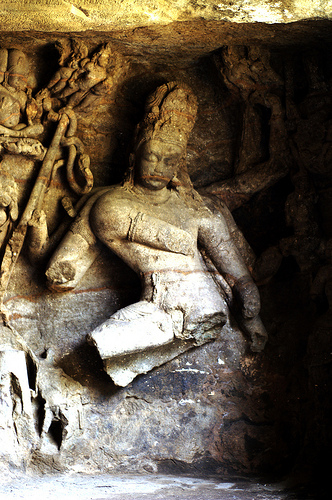- HubPages»
- Travel and Places»
- Visiting Asia»
- Southern Asia
The Aesthetic Elephanta Caves of Mumbai


Just imagine the time required for drawing an object on a piece of paper. If the object has several embellishments detailed in it, then obviously time becomes a matter of concern. When it comes to that of a sculptor, the time and hard work he puts in for molding the object to give it life is incomparable. Elephanta Caves located in Elephanta Island in Mumbai is one such fine artwork of some ancient sculptors. It is worth praising for the fine craftsmanship involved in carving and polishing so many divine sculptures engraved in panels. But most of them got ruined during the colonial rule that defaced their great artistry.
The Elephanta Caves are a network of rock cut caves located on Elephanta Island or Gharapuri meaning 'city of caves' in Mumbai Harbor. It is 10 kilometers away from the city of Mumbai in the Indian state of Maharashtra. The island, located on an arm of the Arabian Sea is a hill that anchors two groups of caves. The first is a large group of five Hindu caves and the second is a smaller group of two Buddhist caves. Hindu caves have several rock-cut engravings of different poses of Lord Shiva of his life stages and Buddhist caves are mainly comprised of Stupa. Because of the huge statue of an elephant that stood in front of the caves, the island came to be known as Elephanta Island.

How to reach Elephanta Caves
The caves can be accessed by a ferry from the Gateway of India bay. The one hour cruise in the bay with its rhythmic waves itself is delightful. After boarding the Elephanta island, a long pier takes you near the caves. A toy train runs through this pier to take the passengers to and fro. Or you can walk the entire pathway luring the shore views of mangroves in the sandy mud water. The pathway ends at the bottom of the hills from where narrow steep thousand steps high up lead to the entrance of Elephanta Caves. While climbing these steps, stalls selling traditional as well as modern artifacts also attract the visitors.



Hindu Caves of Lord Shiva
The central shrine of all the five caves is Shiva Linga. The first cave is the main cave which is very big, anchoring a major part of the sculpted art. The entrance to this cave is a hall laid with porticoes surrounded by pillars. They date back to the ancient Gupta-Chalukya period. The two panels on either side of the walls portray Lord Shiva’s two poses, Yogishwara and Nataraja. Yogishwara really looks like Sri Buddha as he is doing meditation in the pose of Padmasana. The broken arms don’t spoil the charming look of the Yogi as it is the paramount of art. Nataraja pose is Lord Shiva’s dance Thandava in which he is portrayed with ten arms amidst his celestial family.
Further inside, the back of the wall facing the entrance is where Trimurti appears. The three faces of Lord Shiva meaning creation, protection and destruction are being precisely sculpted in this masterpiece of art. The central piece has Gangadhara and Ardhanariswara sculpted to its right and left chambers respectively. In his Gangadhara pose, Lord Shiva beholds Ganga River on his head. Gangadhara and Parvati together with the divinities are being elegantly featured through this sculpt. Ardhanariswara is Lord Shiva’s pose of embodying half part of his consort Parvathi. The central shrine of this cave Shivalinga is installed on a freestanding square chamber in the right section of this hall with doors opened on all the sides. The guards or dwarpalakas carved on the corners look after this linga. Other sculptures of Lord Shiva on the walls of this great cave include Kalyanasundaramurti (Marriage of Lord Shiva to Parvathi), Andhakasuravadhamurti (Lord Shiva as Bhairava slaying the demon Andhaka) and Ravananugraha (Mount Kailash shaken by the demon king Ravana).
The main cave has openings on either side that open to the courtyards of lateral caves. One cave is a temple of Lord Shiva with Linga, Lion Guards, giant doorkeepers and Ashta matrikas (eight mother goddesses) followed by Kartikeya and Ganesha, the sons of Lord Shiva.
A little ahead of the Main Cave is the network of other 4 caves which have Shiva linga as the center of worship. These temples suffer from water damage and so they are in semi-ruined state.
Elephanta Caves was renovated in the 1970s and was designated a UNESCO World Heritage Site in 1987. It is currently under the maintenance of Archaeological Survey of India. Visiting this monument would take you dates back to the aura of celestial figures with a twist from the common perceives.


Please vote!
Have you visited Elephanta Caves? Do you admire its craftsmanship?
The Elephanta Caves, Mumbai
The Elephanta Caves are a network of rock cut caves located on Elephanta Island or Gharapuri (literally "the city of caves") in Mumbai Harbor.
- Top Ten Hotels in Mumbai, India
Mumbai is city of dreams which turns them into reality. Its rich heritage monuments and diverse culture attracts a lot of tourists every year. There are a large number of hotels that cater to the needs of the visitors in this biggest Metropolitan of - Places to visit in a travel to Mumbai, India
Mumbai is the capital of the Indian state of Maharashtra. It is the most populous metropolitan city in India and the fourth most populous city in the world with a total population of about 20.5 million. Mumbai lies on the west coast of India and has
© 2013 Radhika Sreekanth








